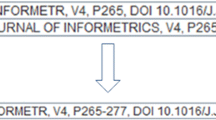Abstract
The paper discusses the often lamented lack of a theory of citations, and the lack of a sociological theory in particular. It draws attention to one proposed theory and discusses the potential reasons why it has not been generally accepted as the theory of citations, despite its merits in explaining many phenomena in the citation behaviour of scientists. This theory has been expounded by Latour and presented, in particular, in his book entitledScience in Action.
Similar content being viewed by others
References
B. Latour,Science in Action: How to Follow Scientists and Engineers Through Society, Open University Press, Milton Keynes, 1987.
N. Kaplan, The norms of citation behaviour: Prolegomena to the Footnote,American Documentation, 16 (1965) 179–184.
R. K. Merton, Foreword, in:E. Garfild Citation Indexing: Its Theory and Application in Science, Technology, and Humanities, John Wiley & Sons, New York, 1979, vii-xi.
E. Garfield,Citation Indexing: Its Theory and Application in Science, Technology, and Humanities, John Wiley & Sons, New York, 1979.
J. R. Cole, S. Cole,Social Stratification in Science, University of Chicago Press, London, 1973.
F. Narin,Evaluative Bibliometrics: The Use of Publication and Citation Analysis in the Evaluation of Scientific Activity, Computer Horizons Inc., Cherry Hill, New Jersey, 1976.
B. R. Martin, J. Irvine, Assessing basic research: Some partial indicators of scientific progress in radio astronomy,Research Policy, 12 (1983) 61–90.
G. N. Gilbert, Referencing as persuasion,Social Studies of Science, 7 (1977) 113–122.
M. H. Macroberts, B. R. Macroberts, Quantitative measures of communication in science: A study of the formal level.Social Studies of Science; 36 (1986) 223–229.
M. H. Macroberts, B. R. Macroberts, Testing the Ortega Hypothesis: Facts and artifacts,Scientometrics, 12 (1987) 293–295.
Scientometrics, 12 (1987) Nos 5–6.
H. Small, Citation context analysis, in:B. J. Dervin, M. J. Voigt (Eds),Progress in Communication Sciences, Ables, Norwood, NJ, 3 (1982) 287–310.
B. Cronin,The Citation Process, Taylor Graham, London, 1984.
M. Callon, J. Law, A. Rip, Qualitative scientometrics; in:M. Callon, J. Law, A. Rip (Eds),Mapping the Dynamics of Science and Technology, The Macmillan Press Ltd, Houndmills and London, 1986, 103–123.
D. Edge, Quantitative measures of communication in science: A critical review,History of Science, 17 (1979) 102–134.
S. Woolgar, Beyond the citation debate: Towards a sociology of measurement technologies and their use in science policy.Science and Public Policy, 18 (1991) 319–326.
H. Zuckermann, Citation analysis and the complex problem of intellectual intluence,Scientometrics, 12 (1987) 329–338.
S. E. Cozzens, What do citations count? The rhetorical-first model,Scientometrics, 15 (1989) 437–447.
T. Luukkonen, Citations in the rhetorical, reward, and communication systems of science,Acta Universitatis Tamperensis, ser A, vol. 285, Tampere: University of Tampere 1990.
L. Leydesdorff, O. Amsterdamska, Dimensions of citation analysis.Science, Technology, & Human Values, 15 (1990) No. 3, 305–335.
H. Small, Cited documents as concept symbols,Social Studies of Science, 8 (1978) 327–340.
D. De Solla Price,Little Science, Big Science … and Beyond, Columbia University Press, New York, 1986.
L. Leydesdorff,The Challenge of Scientometrics: The Development, Measurement, and Self-Organisation of Scientific Communications, DSWO Press, Leiden, 1995.
M. J. Mulkay, Some aspects of cultural growth in the natural sciences,Social Research, 36 (1969) 22–52.
I. I. Mitroff,The Subjective Side of Science, Elsevier, New York, 1974.
B. Latour, S. Woolgar,Laboratory Life: The Construction of Scientific Facts, Princeton University Press, Oxford, 1986.
T. S. Kuhn,The Structure of Scientific Revolutions, The University of Chicago Press, Chicago, 1962.
K. D. Knorr-Cetina, M. Mulkay, Introduction: Emerging principles in social studies of science, in:K. D. Knorr-Cetina, M. Mulkay (Eds),Science Observed, Perspectives on the Social Study of Science, Sage, London, 1983, p. 1–17.
E. Garfield, Derek Price and the practical world of scientometrics,Science, Technology, & Human Values, 13 (1988) 349–350.
Author information
Authors and Affiliations
Rights and permissions
About this article
Cite this article
Luukkonen, T. Why has Latour's theory of citations been ignored by the bibliometric community? discussion of sociological interpretations of citation analysis. Scientometrics 38, 27–37 (1997). https://doi.org/10.1007/BF02461121
Received:
Issue Date:
DOI: https://doi.org/10.1007/BF02461121



